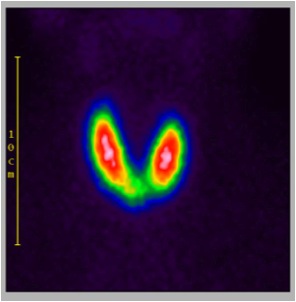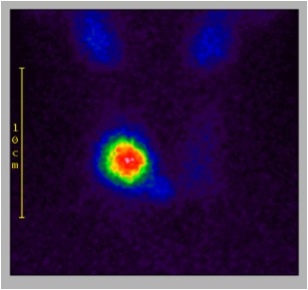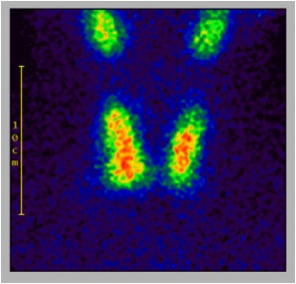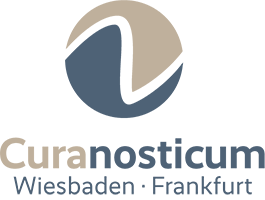To the performance overview
Thyroid diagnostics and therapy
The thyroid gland is a butterfly-shaped organ that is in the front neck region. It produces the vital thyroid hormones. The most frequent thyroid disease in Germany is the “goitre”, an enlargement and / or nodulous change of the thyroid gland. This is usually caused by iodine deficiency. Besides, there are often immune diseases of the thyroid gland and less frequent thyroid cancer. If the level of the thyroid hormones is too high or low it might cause functional disorders in different organs. An overactive thyroid (hyperthyroidism) can manifest itself in nervousness, sleep disturbances, sweating, heart palpitations or weight loss. An underactive thyroid (Hypothyroidism) may be e.g. being cold or fatigue.
The size of the thyroid gland as well as different disorders of the thyroid gland can be detected with thyroid gland ultrasound. The disorders include thyroid nodules as well as inflammation or enlargement of the thyroid gland. An ultrasound may also be necessary for therapy monitoring and for tumour search. As a special method, we offer the ultrasound elastography of nodes, which can be used to examine how hard or soft a node is. This can help in assessing the benignancy or malignancy of a node.

Figure: Thyroid scintigraphy displays the butterfly shape of the thyroid gland
Thyroid scintigraphy is a nuclear medical examination in which the function of thyroid nodules and the entire thyroid gland can be visualized. For this purpose, a small amount of a low-radioactive substance is administered to you. This substance will accumulate in the thyroid gland and emit rays. The rays can then be measured as an image (scintigram) with a gamma camera.
The examination makes it possible to assess the nodular changes of the thyroid gland and to determine whether normal, cold or hot nodes are present. “Hot” nodes work too much and can cause hyperthyroidism. “Cold” nodes work too little and can be malignant. Scintigraphy of the thyroid gland becomes necessary if nodular structures are detected in the thyroid gland or if we need additional information about thyroid’s function.
Examination procedure
To determine if your thyroid gland is infected, we first ask you about your complaints and your medication. We then examine you physically. In most cases, blood samples are taken, e.g. thyroid hormones and antibodies. The laboratory values indicate whether there is an over or under function of the thyroid gland. They can also indicate the cause of the functional disorder.
Thyroid ultrasound
The examination takes place in lying position. If it shows abnormalities, scintigraphy may be necessary to clarify the findings.
Scintigraphy of the thyroid
First, a small amount of a low-radiation marker substance will be injected. This substance will accumulate in the thyroid cells short time after the injection.
The substances used are very well tolerated; allergic reactions are not known. The radiation load is low and quickly degraded.
About fifteen minutes later images of the thyroid are recorded with a gamma camera. The recording takes about five to ten minutes.

Fig. 1: thyroid scintigraphy shows an over activity of the “hot” node in the thyroid gland (left), the healthy tissue is suppressed

Figure 2: the healthy tissue is active after a radioiodine therapy, the “hot” node is no longer active
Puncture of the thyroid gland
If a cold node – which might be malignant – is found it is often useful to take a tissue sample / biopsy. Cells are taken with a very fine needle (similar as when taking blood) and are examined microscopically.
Preparation before and after the examination
You may have your meals before the examination.
Please do not take your thyroid gland medication on the day of the examination.
Please inform us if you had had any tests or treatments using iodinated contrast material (for example X-ray/CT) or medication with high iodine load such as cordarex, as this might affect the accuracy of the scintigraphy.
We will send the examination results to your treating physician as soon as possible. He will then contact you to discuss the results as well as the possibility of a treatment.
Please do not hesitate to contact us if you have any further questions!

